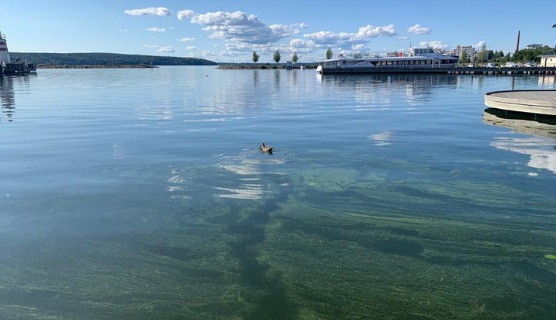Hot weather boosts cyanobacteria blooms but still below average
Published : 30 Aug 2021, 22:29
Updated : 30 Aug 2021, 22:31
The cyanobacterial situation has varied in both Finnish lakes and sea areas during this summer, according to the Finnish Environment Institute (SYKE).
The amount of cyanobacteria was exceptionally at its peak in the sea areas already in mid-July, said the SYKE in a press release on Monday.
Even in inland waters, the sunny and calm weather of early summer, as well as the warm waters, accelerated the growth of cyanobacteria, and as a result cyanobacteria began to bloom earlier than usual at many of the national algal monitoring sites.
Nonetheless, fewer cyanobacterial blooms were observed at the national cyanobacterial monitoring sites in most parts of the country after mid-July.
In the Gulf of Finland, the formation of cyanobacterial blooms was curbed by the lack of alternating periods of suitable phosphorus nutrient additions from the deep waters to the surface and subsequent longer windless periods and by the strong cooling of the seawater due to long-lasting upwelling as happens in very strong bloom tears.
In Finnish sea areas, the peak of cyanobacterial observations occurred exceptionally in mid-July, when it typically occurs in the turn of July–August.
After mid-July, the number of cyanobacterial observations decreased significantly, and the cyanobacterial situation was even better than normally from mid-July to the end of August.
This was mainly due to the fact that fewer cyanobacterial observations were made in the Gulf of Finland than usual.
Very strong and extensive cyanobacteria surface rafts did not form in the Finnish offshore areas. Still, in the central parts of the Bothnian Sea, as in recent years, there was widespread cyanobacteria in the vicinity of the surface and occasionally on the surface.
“Nationwide, the amount of cyanobacteria in the sea areas near Finland peaked in mid-July, which is slightly earlier than usual. Thereafter, the amount of cyanobacterial blooms decreased based on the observations reported to the Järvi-meriwiki online service, satellite observations, and the species, biomass, and pigment results of cyanobacteria at the Utö Atmospheric and Marine Research Station. The most abundant cyanobacteria found in front of Utö were of the genera Aphanizomenon and Dolichospermum, but the amount of Nodularia spumigena was smaller,” said Senior Research Scientist of SYKE Sirpa Lehtinen.
Warm weather accelerated the rise in sea surface temperature in early summer, and this promoted the growth of cyanobacteria. After Midsummer and at the beginning of July, cyanobacteria were extensively mixed with water in Finland's southwestern and southern offshore areas.
Cyanobacteria were also found especially in sheltered bays in all coastal and archipelagic areas of Finland; in the Gulf of Finland, the Archipelago Sea, Åland and the Bothnian Sea as far as the Quark. Similarly, abundant cyanobacteria were reported off the coast of the Gulf of Bothnia, and according to the ELY Center for Northern Ostrobothnia, sea surface temperature at monitoring sites on the Gulf of Bothnia had risen to a record 22.2°C, which had contributed to the growth of cyanobacteria.
In mid-July, some cyanobacterial blooms were found close to the surface and occasionally on the surface, especially in the offshore areas of the Bothnian Sea, but also in the Archipelago Sea. Most of the cyanobacterial observations reported to the Järvi-meriwiki in mid-July came from the Archipelago Sea.
However, in the central parts of the Archipelago Sea and in the Gulf of Finland, the amount of cyanobacteria was moderate even in mid-July, according to satellite images.
After mid-July, a large cyanobacterial occurrence that had been in the offshore areas of the Bothnian Sea for weeks mixed with the water. In coastal and archipelago areas, the cyanobacterial situation calmed down and the national cyanobacterial barometer remained below normal throughout the end of July. At the beginning of August, upwelling, where the deeper old water mass rose to the surface, was observed in almost all of the Finnish coastal areas.
The upwelling further reduced the formation of cyanobacterial blooms, as the cyanobacteria-rich surface water gave way to the deeper water body and, in addition, the surface water temperature dropped sharply. The upwelling situation continued, so in the cool body of water, the cyanobacteria could not effectively utilise the phosphorus nutrient that had risen from the bottom. This affected the biomass of cyanobacteria, i.e., the amount of cyanobacteria in the water.
For these reasons, the cyanobacterial situation in the Gulf of Finland, in particular, was very different from 2018.
In 2018, the cyanobacterial situation in the Gulf of Finland developed particularly bad due to warm seawater and the alternating periods of suitable phosphorus nutrient additions to the surface and subsequent longer windless periods. Similar favourable conditions for the growth of cyanobacterial biomass and the formation of surface rafts did not exist in the Gulf of Finland this summer.
“For the offshore areas near Finland, wind conditions were one of the essential reasons why cyanobacteria did not accumulate as surface rafts during the past summer. Since we didn’t experience longer windless periods, the cyanobacteria mass accumulating in the surface layer remained mainly mixed with water in larger offshore areas in the Gulf of Finland, for example," said Senior Research Scientist of SYKE Jenni Attila.
Over the last monitoring week, rainy and windy weather has further reduced cyanobacterial blooms, which are now clearly below average. No very abundant cyanobacterial blooms have been observed. Abundant blooms are currently present at five sites and minor blooms at 27 sites.


